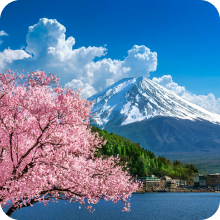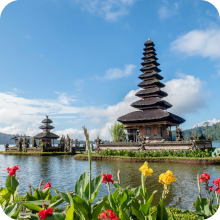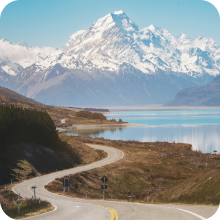When is the Best Time of Year to Visit Japan?
Welcome, fellow adventurers! I'm your friendly globe-trotting guide, Bill Bryson, back again with a tale that's as enchanting as a Studio Ghibli movie, a land that's a curious mix of the ancient and the hyper-futuristic. Today, we shall unfurl the rich tapestry that is Japan. And not just the where and the what, but the golden question – when is the best time of year to visit Japan?
Table of Contents
- Exploring Japan's Four Seasons
- Spring in Japan: A Blossoming Beauty
- Summer in Japan: A Festival Fiesta
- Autumn in Japan: A Riot of Colors
- Winter in Japan: A Snowy Wonderland
- Unraveling Japan's Regional Variations
- Japan's Peak and Off-Peak Travel Seasons
- Tailoring Your Activities to the Weather
- Navigating Japan with SimsDirect: Stay Connected 24/7
- Frequently Asked Questions about Travelling to Japan
Ah, Japan! The Land of the Rising Sun, where you can enjoy a soothing tea ceremony in the morning and watch a bout of futuristic robot fighting by evening. But picking the perfect time to visit Japan is as crucial as perfecting the tea-whisking technique in a traditional tea ceremony.
Is it spring, when cherry blossoms paint the land in shades of pink and white that even Bob Ross would be envious of? Or, perhaps it's summer, with its lively festivals that make Woodstock seem like a quiet tea party? Maybe the riot of colors in autumn, that could easily outshine an Instagram influencer's curated feed? Or could it be the snow-dusted winters that transform Japan into a real-life version of Frozen? Elsa and Olaf would surely approve!
Well, folks, pack your bags, grab your reliable SimsDirect travel sim cards, and buckle up. Together, we are going on a journey that's as thrilling as a high-speed ride on the Shinkansen, exploring the beauty of Japan through each season. Let's unravel the best time to visit Japan, ensuring you're at the right place at the right time, a feat even Doctor Who would appreciate.
If you're ready, let's say "ikimashou" (let's go), and jump right into it, just like Mario heading into one of his adventures. Up next, we're exploring Japan's four distinct seasons, each with its unique charm and attractions. No need for a TARDIS here; we've got all the time in the world to discover the best of Japan. Stay tuned!
Exploring Japan's Four Seasons
Step aside, Vivaldi! There’s no concerto that can quite match the mesmerizing orchestra of sights, sounds, and experiences that each season brings to Japan. So, put on your best time-traveling hats (sorry, no DeLoreans or flux capacitors in this tale), and let's dive into each season.
Spring in Japan: A Blossoming Beauty
To quote the ever-wise Ned Stark from Game of Thrones, "Spring is coming". And nowhere is it more eagerly awaited than in Japan. Why, you ask? Two words: cherry blossoms. Locally known as sakura, these ethereal flowers transform Japan into a real-life Monet painting. Parks, temples, castles, everywhere you look is an explosion of delicate pinks and whites.
The cherry blossom season is such a grand spectacle that it has a dedicated forecast on Japanese news. Yes, you heard that right. The nation eagerly follows the "sakura zensen" or cherry blossom front as it sweeps from Okinawa in the south in late January to Hokkaido in the north by May. Can you imagine CNN forecasting blooms instead of blizzards?
Cities like Tokyo, Kyoto, and Osaka offer breathtaking views, but for a truly magical experience, head to Hirosaki Castle or Mount Yoshino. These are the Avengers Endgame of cherry blossom spots – the showstoppers. You also shouldn't miss 'Hanami,' traditional cherry blossom viewing parties. They're like Coachella, just with less glitter and more grace.
Summer in Japan: A Festival Fiesta
Summer in Japan is like a never-ending episode of Friends. It’s warm, it's fun, and there's always something happening. Japanese summers are synonymous with lively festivals known as "matsuri". Imagine the colors of Mardi Gras, the vibrancy of Rio's Carnival, and a dash of local tradition.
You'll find street parades with floats and traditional music, folk dancing, and copious amounts of delicious street food. Two notable events are Kyoto's Gion Matsuri, a month-long festival with extravagant processions, and Aomori's Nebuta Matsuri, where enormous, illuminated floats make for a spectacle straight out of a Miyazaki movie.
And for all you wrestling enthusiasts, it's also the season of Sumo tournaments in Tokyo and Nagoya. As gripping as a season finale of Breaking Bad, but with more Chanko Nabe (a sumo wrestler's staple dish)!
Fancy a climb? Summer is the only time when you can hike up the iconic Mount Fuji. Nothing screams 'top of the world' more than standing on Japan's highest peak, possibly humming the theme from Rocky.
Autumn in Japan: A Riot of Colors
Autumn in Japan is like a scene from Disney's Pocahontas – it's all about the colors of the wind. The fall foliage, known as "koyo", turns the country into a riot of reds, oranges, and yellows.
Visit Tokyo's Showa Kinen Park or Kyoto's Tofuku-ji Temple to see nature putting on its own spectacular show, rivaling the biggest fireworks at any Fourth of July celebration.
Winter in Japan: A Snowy Wonderland
If you thought Elsa's powers in Frozen were magical, wait till you experience winter in Japan! The country transforms into a snowy wonderland, especially in regions like Hokkaido and the Japanese Alps.
It's a paradise for winter sports enthusiasts, with top-notch ski resorts like Niseko and Hakuba. But even if you're more into hot cocoa than cold snow, Japan's winter offers unique experiences like soaking in an onsen (hot spring) while snowflakes gently fall around you. Imagine it as your personal outdoor Jacuzzi, courtesy of Mother Nature.
Winter also brings some magical festivals like the Sapporo Snow Festival, where you'll find massive, intricate ice sculptures that would leave even Michelangelo in awe. It's not a bad way to spend a winter evening, right?
Join us next as we journey from Hokkaido's chilly climes to Okinawa's sunny shores. Our next stop: Regional variations across Japan!
And remember, folks, just like in any epic adventure movie, there are no bad times, just different types of experiences. Whether you’re after blossoms or snowflakes, sumo or hot springs, Japan has a season for you. So, stick around, the adventure is just getting started.
Unraveling Japan's Regional Variations
If Japan were a movie, it would be a cinematic universe in itself, each region a unique and captivating sequel (or prequel). Just as you wouldn't mistake Hogwarts for Hobbiton, there's a vast difference between the snowy tales of the North (Hokkaido) and the sunny stories from the South (Okinawa).
The North: Hokkaido's Winter Wonderland
Venturing northward in Japan is like walking into Narnia through the wardrobe. The island of Hokkaido is the star of Japan's winter, with snowfall heavier than Thor's Mjolnir. The Sapporo Snow Festival here is like the Comic-Con of snow sculpture, where artists take the phrase "do you want to build a snowman" to a whole new level.
The local ski resorts become the prime spots for winter sports enthusiasts, making Hokkaido a dream come true for every ski and snowboard enthusiast. Think Aspen, with a dash of Japanese flavor.
Winter aside, Hokkaido is a summer paradise as well. As the rest of Japan swelters, Hokkaido offers cool respite, with attractions like the lavender fields in Furano that could give France's Provence a run for its money.
The South: Okinawa's Eternal Summer
If Hokkaido is Narnia, then Okinawa is straight out of Moana. This southern region skips the cold entirely, boasting a tropical climate that's as warm and welcoming as a Hawaiian luau.
Okinawa is a beach-lover's paradise, with crystal clear waters and abundant marine life. Summer, while hot and humid, is the time for Eisa dance festivals, akin to Rio's Carnival, only with more taiko drums and less samba.
In winter, while the rest of Japan huddles under blankets of snow, Okinawa basks in mild temperatures, perfect for beachside barbecues and exploring the islands' coral reefs. It's a wonderful option for anyone who thinks 'winter is coming' should stay in Game of Thrones and not their travel plans.
Now that we've weathered the seasons and traversed from north to south, let's talk about the times when Japan is buzzing with activity, and when it's quiet enough for a ninja to drop a pin. Stay tuned for the highs and lows of Japan's travel seasons up next!
Japan's Peak and Off-Peak Travel Seasons
When planning your journey to Japan, it's vital to note that certain times of the year are as bustling as a Tokyo subway at rush hour. We're talking about Japan's three major holiday periods: Golden Week, Obon, and New Year.
Golden Week: The Spring Scramble
Golden Week is a series of national holidays clumped together from late April to early May, making it one of the longest and busiest holiday periods in Japan. It's like Japan's version of Spring Break, but with less beach partying and more serene temple visits.
Everything from Shinkansen trains to Disney Tokyo can be packed with locals enjoying their days off. It's like trying to get the newest iPhone on the release day – everywhere's crowded!
Obon: The Summer Exodus
Obon in mid-August is a Buddhist event for commemorating one's ancestors. Think of it as Japan's Day of the Dead, minus the colourful sugar skulls and face paints.
Many Japanese return to their hometowns, leading to significant urban exodus. So, if you thought getting a table at a popular sushi spot was tough, try booking a bullet train ticket during Obon!
New Year: The Winter Rush
New Year is a significant family event in Japan, much like Christmas in the western world. With most businesses closed and many people travelling to spend time with their families, this period can be both bustling and serene. It's a paradox, like having Schrödinger's cat as a travel companion!
Off-Peak Perks
Just as the early bird gets the worm, the off-peak traveller gets the benefits. Travelling outside these peak periods means fewer crowds, easier bookings, and often, cheaper rates. It's like having your own private viewing of a blockbuster movie on a Tuesday afternoon.
While it's important to keep these periods in mind, don't let them scare you off. After all, where's the fun in an adventure without a little unpredictability? The Doctor doesn't avoid the Daleks, does he?
Next, we'll discuss how the weather conditions can impact your activities in Japan, making sure you're never caught out in the rain without an umbrella, both metaphorically and literally! Stay tuned, my fellow travellers!

Tailoring Your Activities to the Weather
Japan's not just a place; it's a myriad of experiences. Whether you're looking to hike up majestic mountains, relax on sandy beaches, soak in historical sites, or explore the urban jungle, the Land of the Rising Sun has it all. The trick is matching these activities to the weather.
Mountainous Adventures
If you're as adventurous as Indiana Jones and mountains call out to you like they did to Bilbo Baggins, then Japan's got quite a treat for you. Mount Fuji, the country's highest peak, is open for climbing only in July and August. So, you'll want to plan your summer around this if you're keen on conquering this beast of a mountain.
Beach Time in Japan
For those who love the beach life, the summer months from June to August are perfect. Okinawa and the Izu Peninsula become your personal Baywatch episodes, minus David Hasselhoff, of course.
Soaking in the Culture
Visiting temples and shrines can be done all year round. However, the ethereal beauty of cherry blossoms in the spring or the vibrant autumn leaves add an extra layer of magic to these historical sites. It's like stepping into a fantasy novel where the settings are as enchanting as the story itself.
Navigating the Urban Jungle
Exploring cities like Tokyo, Osaka, and Kyoto is a year-round activity. Still, spring and autumn offer comfortable temperatures, making them ideal for those long walks in the shopping districts or leisurely strolls in the parks. You'll feel like you're in a real-life version of Crazy Rich Asians, only with more ramen shops and fewer private jets.
So there you have it, my fellow wanderers. The best time to visit Japan depends greatly on what you want to see, do, and experience. But let's not wrap up our adventure just yet. Stay with me as we answer some frequently asked questions about traveling to Japan. No stone will be left unturned, just like a thorough Sherlock Holmes investigation!
Navigating Japan with SimsDirect: Stay Connected 24/7
There's an unsung hero in every great adventure story. In Lord of the Rings, it was Samwise Gamgee. In your travel tale, it's going to be a reliable travel SIM card. Like a dependable sidekick, it stays with you, keeps you connected, and ensures that you don't end up lost like Jack Sparrow without his compass.
And this is where SimsDirect steps into your narrative.
Whether you're navigating through the bustling streets of Tokyo, sharing a selfie from the summit of Mount Fuji, or live-streaming the tranquil beauty of Kyoto's temples, SimsDirect ensures that you're always connected. With their hassle-free service, you can forget about hunting for Wi-Fi or grappling with confusing local data plans.
SimsDirect offers a selection of prepaid travel SIMs, with widespread coverage, fast 4G & 5G speeds, and flexible data options. It's like having your personal TARDIS, ready to keep you connected anytime, anywhere.
So, embark on your Japanese adventure with SimsDirect - because no hero should venture out without their trusty sidekick!
Thanks for visiting our blog, are you planing to travel to Japan? Check out our Japan SIM Card.
Before you take off make sure to check with local government of the travel status.
Frequently Asked Questions about Travelling to Japan
Now that we've traversed through Japan's seasons, regions, and activities, it's time to answer some of those burning questions you might still have. After all, we're on an epic quest for knowledge, much like Frodo's journey to Mount Doom, only with less fire and more fun!
Q1: I've heard about the rainy season in Japan. When is it, and how does it affect travel?
Ah, the 'tsuyu', or the rainy season. Typically, it occurs in early summer from June to mid-July. While it might sound as daunting as the Night King's arrival, it's not all that bad. The rain is usually more of a daily drizzle than a torrential downpour.
However, this is a fantastic time to visit the indoor attractions or enjoy a traditional tea ceremony. It's like taking a day to Netflix and chill, only with more green tea and less popcorn.
Q2: I'm a foodie. When is the best time to visit Japan for a culinary adventure?
The delightful thing about Japan's culinary scene is its seasonality. Spring offers delicacies like takenoko (bamboo shoots) and sakuramochi (a pink, cherry blossom-infused sweet). Summer is the time for cool soba noodles and kakigori (shaved ice dessert). Autumn brings a bounty of mushrooms and sweet potatoes, while winter is the season for Fugu (pufferfish) and hot pots.
So, in essence, there's never a bad time for a foodie adventure in Japan. It's like a never-ending feast at Hogwarts, with fewer floating candles and more sushi.
Q3: I want to experience Japan's pop culture and anime scene. When should I go?
For anime and manga lovers, events like Tokyo's AnimeJapan in March and Kyoto International Manga Anime Fair in September are must-visits. For a Studio Ghibli experience, their Tokyo museum is open year-round but remember to book in advance.
In a nutshell, Japan's pop culture scene is as lively as a dance-off in a Guardians of the Galaxy movie, and there's always something exciting around the corner.
That wraps up our thrilling journey through Japan's four seasons. So, when is the best time to visit Japan? The answer, my dear travellers, is as unique as your own adventure tale. It's not about finding the "perfect" time but about creating your perfect experience. Just remember, as the Japanese proverb goes, "Even a road of thousand miles begins with a single step". So, take that step, embark on your journey, and create your own memories under the Rising Sun.
Until our next adventure, sayonara, and happy travelling!









